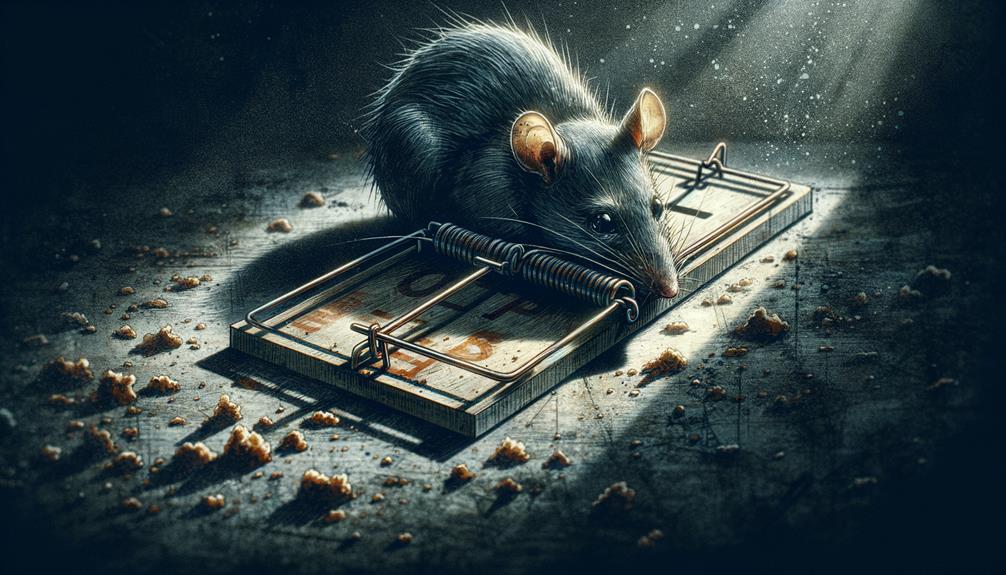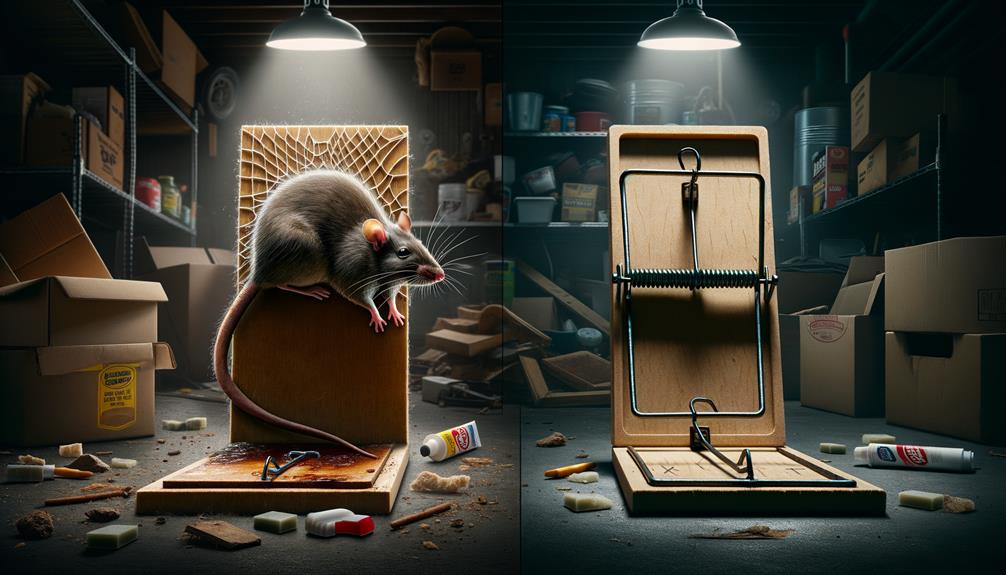Surprisingly, a rat can linger in the adhesive grip of a glue trap for an agonizing span of several days. As you might imagine, these devices don’t offer a swift end; instead, they condemn the ensnared creature to a grim countdown of exhaustion and dehydration.
You’re probably pondering the humane aspect of this method and whether there are more compassionate alternatives to rodent control. The ethical debate around glue traps is as sticky as the traps themselves, raising significant concerns about animal welfare.
Let’s explore this controversial topic further and consider what solutions might strike a balance between efficacy and ethics.
Key Takeaways
- Rats can live for hours to days in glue traps, enduring prolonged distress.
- Immobilization from glue traps exacerbates suffering due to exhaustion and dehydration.
- The survival timeline worsens with attempted escapes, leading to further injuries.
- Timely rescue and rehabilitation are crucial to mitigate the severe impact on well-being.
Understanding Glue Traps

Glue traps, designed to immobilize animals through a strong adhesive, often lead to prolonged suffering and indiscriminately capture non-target species, raising significant ethical and health concerns. You mightn’t realize it, but these trapping methods pose grave dangers to animal welfare. Imagine being stuck, unable to move, for hours or even days. This is the harsh reality for animals caught in glue traps, who may suffer from exhaustion, dehydration, or worse, break their bones in desperate attempts to escape.
What’s troubling is that glue traps aren’t meant to kill. They merely capture, leading to prolonged periods of animal suffering. This indiscriminate approach means that not only the intended pests, like rats, are caught but also non-target animals such as birds, bats, and even pet cats can become unintended victims. Moreover, the Centers for Disease Control and Prevention highlight another dark side to these traps—the increased risk of disease transmission from trapped animals, adding a layer of public health concern to the ethical implications.
Understanding the inherent dangers and suffering associated with glue trap use is vital. It’s a call to consider more humane and selective trapping methods that safeguard animal welfare and public health.
Factors Influencing Survival
Several factors, including exhaustion, dehydration, and injuries, significantly impact how long a rat can endure being trapped in a glue trap. When you imagine the plight of these creatures, it’s crucial to understand that their struggle to escape isn’t merely a physical battle but an emotional ordeal. The impact of stress on these small beings can’t be overstated.
As they exert themselves in a desperate bid for freedom, their bodies rapidly deplete energy reserves, leading to exhaustion. This exhaustion, in turn, weakens their ability to continue the fight, diminishing their chances of survival with each passing moment.
Dehydration effects quickly follow, compounding their dire situation. Without access to water, their systems begin to fail, making dehydration a critical factor that shortens their survival time significantly. Moreover, the physical injuries sustained during their frantic efforts to escape can lead to broken bones and open wounds, which not only cause immediate pain but also increase susceptibility to infections and further health complications.
Understanding these factors fosters a deeper empathy towards these animals and highlights why glue traps are considered inhumane. It’s a poignant reminder of the suffering involved and the urgent need for more compassionate approaches to rodent control.
The Survival Timeline

Understanding the factors that influence survival sheds light on the harsh reality faced by rats in glue traps, where they can endure for hours and sometimes days. The strong adhesive immobilizes them, leading to a prolonged and distressing ordeal. As you learn about their survival strategies, it’s important to recognize the psychological impact this experience has on them. The struggle and stress of attempting to escape can cause exhaustion and dehydration, significantly affecting their well-being.
Despite their resilience, the extended period rats spend stuck in these traps doesn’t lead to a quick or humane end. Instead, it prolongs their suffering before eventual death, highlighting the inhumane nature of glue traps. This prolonged survival time raises concerns about the long-term effects on any rat that might be rescued.
Efforts to rescue and rehabilitate rats from glue traps are crucial, as they provide a chance to mitigate the suffering and offer a glimpse of hope amidst a painful situation. By understanding the survival timeline and advocating for rescue efforts, you join a community committed to compassion and humane treatment of all beings, irrespective of size or species.
Ethical Considerations
One must consider the deep ethical implications of using glue traps, as they not only cause prolonged suffering to rats but also risk ensnaring unintended victims. The facts lay bare a distressing scenario where animals, caught in these traps, endure hours or even days of agony before finally succumbing to exhaustion, dehydration, or injuries. This prolonged distress underscores the urgent need for a conversation around animal welfare and the moral implications of such methods.
The indiscriminate nature of glue traps further complicates the ethical landscape. Non-target animals, including pets and wildlife, can become unintended victims, amplifying the ethical dilemmas surrounding their use. It’s crucial to recognize the inherent value of all living beings and consider the moral weight of causing unnecessary suffering.
Ethical considerations demand a shift towards minimizing animal suffering. This involves a critical evaluation of rodent control methods and a collective push for humane alternatives. As members of a compassionate society, it’s your responsibility to advocate for practices that respect animal welfare and question those that don’t align with these values. Let’s engage in this dialogue with empathy, understanding, and a commitment to ethical integrity.
Alternatives to Glue Traps

In light of the ethical concerns surrounding glue traps, it’s crucial to explore humane alternatives that effectively manage rodent populations without causing unnecessary suffering. Live trapping and relocation offer a compassionate solution. These methods allow you to safely capture rodents and release them far from your home, ensuring they’re unharmed during the process. By focusing on live trapping, you’re not only addressing the rodent issue but also respecting the life of each creature involved.
Electronic elimination stands out for its efficiency and humanity. These traps swiftly end a rodent’s life without the prolonged suffering associated with glue traps. They’re designed to be as painless as possible, providing a quick resolution to an unwelcome infestation. This approach balances the need to control rodent populations with a commitment to humane treatment.
Moreover, integrating preventative measures such as rodent-proofing your home, utilizing ultrasonic repellents, and employing natural deterrents like peppermint oil or vinegar can significantly reduce the likelihood of rodents entering your space. These strategies create a long-term solution that’s both effective and kind, fostering a sense of belonging among all inhabitants of your home, human or otherwise.
Conclusion
You’ve learned that rats can endure hours to days in glue traps, suffering greatly before death. Factors like exhaustion and dehydration play roles in their survival timeline.
Ethically, this method of pest control raises serious concerns due to the prolonged suffering it causes. For instance, imagine a rat, trapped and struggling for days, a clear call for more humane alternatives.
There are effective, compassionate options available that avoid such cruelty, underscoring the need to reconsider glue traps in rodent management.
You may also enjoy reading this article
Was This Article Helpful?
- Please provide feedback and comments to help us improve our content.
- Share your experiences and any additional tips you have for dealing with pests.
Share this Post



